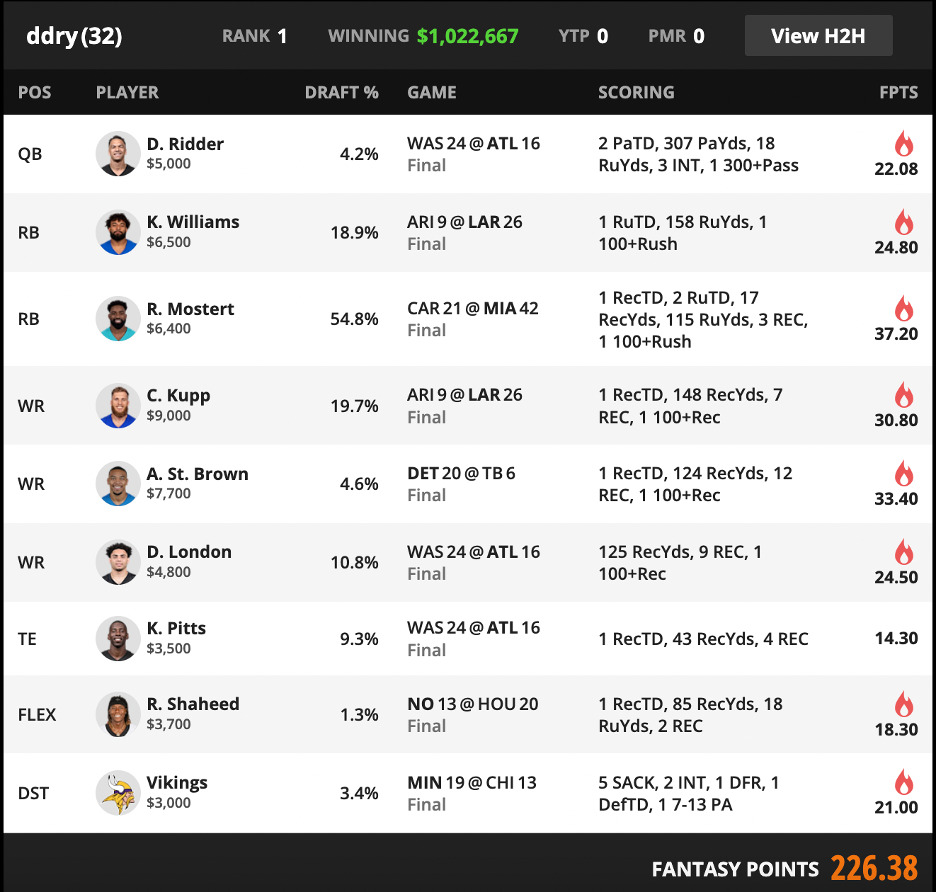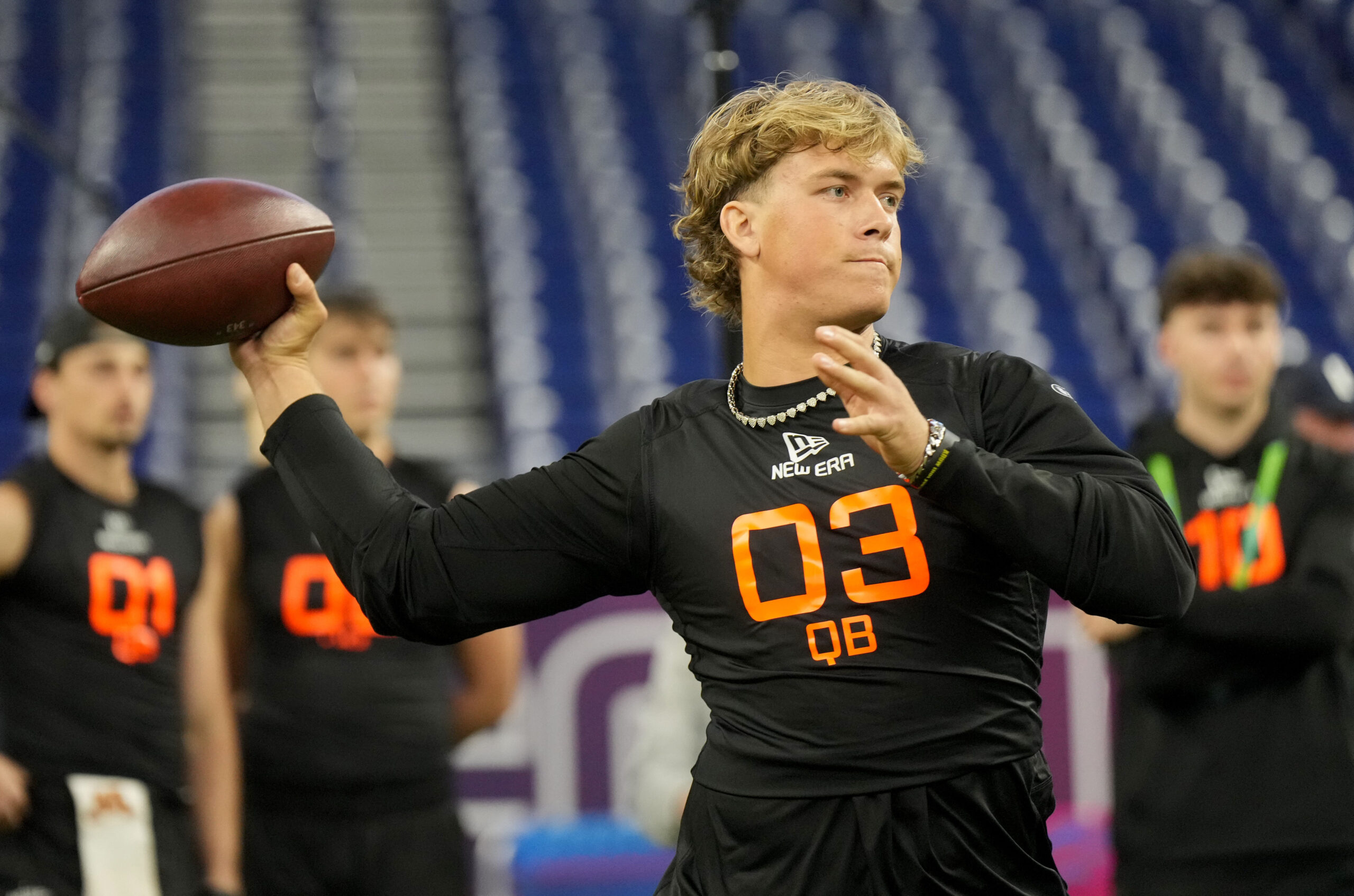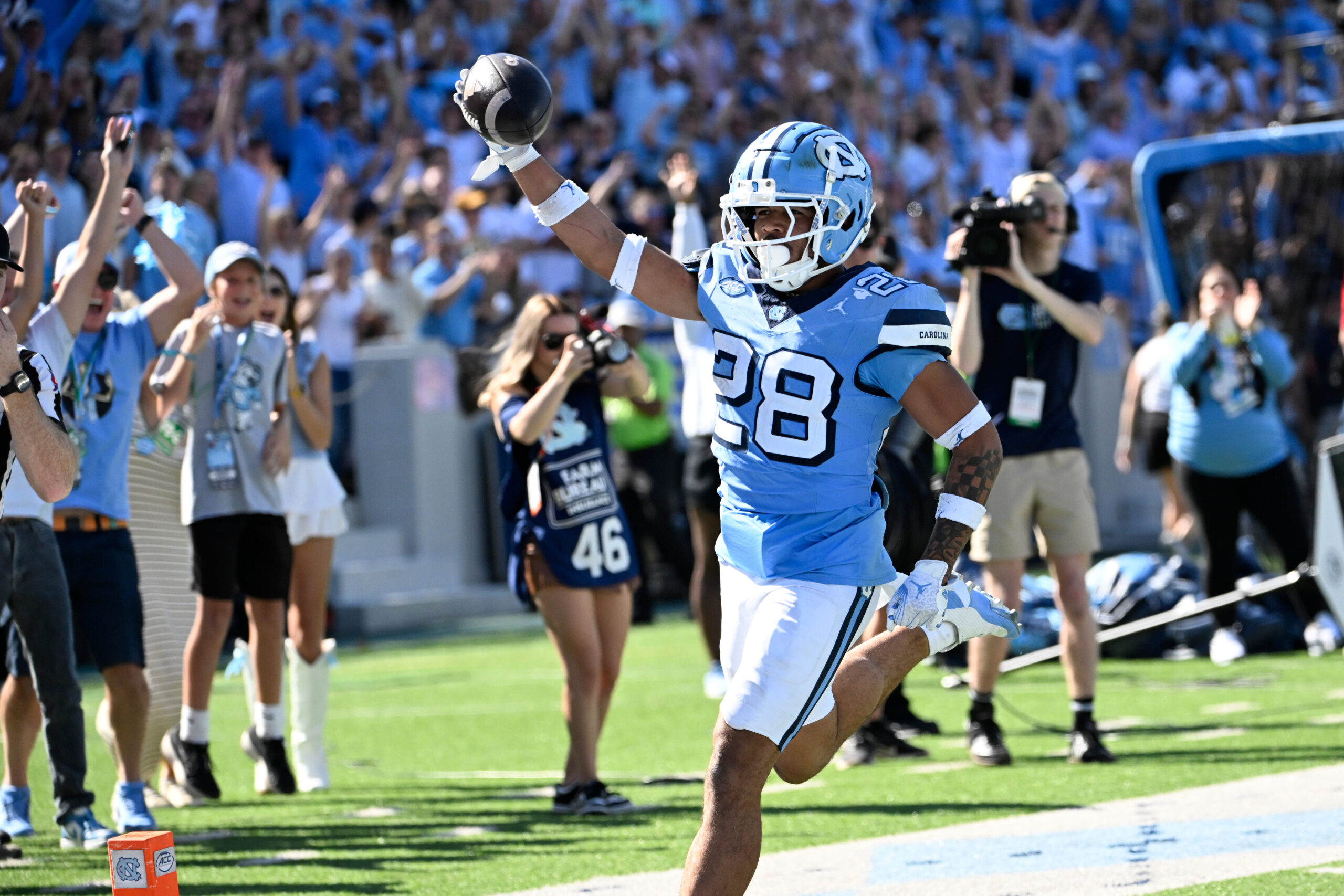Analysis
10/18/23
7 min read
2023 NFL Week 6 DFS Lineup Recap: What We Can Learn From Results

Reflection is an extremely underrated aspect of consistent DFS play. Think about this: How do pitchers, wide receivers or financial analysts remain on top?
They do so by learning, growing, being open to new ideas and practices, tweaking what works and doesn’t and changing with the games themselves.
Reviewing your mistakes can give you staying power in any competition. Most of the top DFS players examine their play the following week — so what edge can we gain over even the most die-hard players?
Let’s examine the Week 6 slate and compare those conclusions with rosters from some of the top players in the game.
Week 6 DFS Lessons Learned
Week 6 Observations
Once again, chalk at the running back position was present on most of the rosters on the top of leaderboards. This week, however, there were some extremely solid on-paper plays at other positions that were going relatively overlooked heading into the weekend. Two of those plays proved crucial to the slate — if you didn’t have them on your roster, you weren’t winning much.
We’ve talked multiple times this season about how scoring is down across the league and how we need to be tailoring our DFS play to the new environment. But the field continues to struggle with the optimal way of dealing with those changes.
“Standard DFS cores” of a quarterback with one of his pass-catchers and a correlated bring-back continue to be overplayed by the field. That roster construction has been present on zero Millionaire Maker winners or on any of the optimal rosters through six weeks. And yet, that roster construction starting point has been hammered into our psyche over the previous five years or so. This provides those who are early to adapt a classic opportunity to generate leverage on the field, effectively avoiding negative expected value tendencies along the way.
But why is that roster construction core no longer the best way to construct rosters?
The tendency to build rosters with a quarterback plus one of his pass-catchers plus a correlated bring-back came at a time when teams were scoring more each game. Remember, scoring over the previous decade spiked in 2020 when teams scored 2.88 touchdowns per game. That number is below 2.30 this season, meaning each team in the NFL is averaging more than half a touchdown less per game than they were just three short years ago. That is a noticeable deviation.
If teams across the league are scoring fewer points, game environments become less necessary to attack in DFS because there are fewer game environments that develop into something that breeds fantasy production from both sides. Theoretically, this would shift the focus of our DFS play to team stacks and team over-stacks.
The reasoning goes as follows: If a team vastly overperforms relative to its implied team total, players from that team become that much more valuable to DFS due to the condensed scoring among its players. Because it is not far less likely that their opponent is also scoring in the same game, game stacks become less viable from a theoretical perspective. The biggest exception to that theoretical reasoning is introduced through a game over-stack, which attempts to capture elite upside from both sides of a game.
These outbursts, although less frequent now, gain importance when they do hit. Again, this is due to the state of the league and the fact that scoring is down. These games will develop at far lower frequency, meaning we’re likely to go multiple weeks without one of these game environments. But when they do show up, we will need their fantasy output or we won’t have a shot at winning on that particular slate.
This makes team stacks our focus, with increased emphasis on game environment over-stacks, both of which leverage the current field tendencies of building around a “standard DFS core” of a quarterback plus one pass-catcher plus a correlated bring-back. Basically, we can generate leverage simply by adapting to the current scoring environment in the league before the field does, without introducing suboptimal plays.
Roster Examination
Once again, we see a team stack without a bring-back present on the winning Millionaire Maker roster in Week 6. DraftKings user ddry attacked the underperforming Washington Commanders secondary with one of the most under-owned primary team stacks of the week in the Atlanta Falcons.
Quarterback Desmond Ridder set career highs in pass attempts and pass yardage against the pass-funnel nature of the Commanders on his way to 307 yards and two touchdowns through the air. Of his 47 pass attempts, 12 were directed toward WR Drake London and 11 more toward the primary tight end duo of Kyle Pitts and Jonnu Smith, the latter two of whom found the end zone as well.
As you can see, that increase to pass volume away from the standard tendencies of the Falcons did not necessarily force increased aggression from their opponent, instead allowing the Commanders to grind their way to victory through three interceptions and a slowed pace of play.
On that topic, let’s pause this discussion momentarily for a quick aside. The general fantasy community still views interceptions as a negative in DFS. But if we boil down turnovers into what they create for a game environment, we realize that they force increased aerial aggression from the remaining possessions from that team. These interceptions, paired with an ineffective run game against a pass-funnel opponent, forced a team that isn’t known for crazy pass volume into their highest output of the season once in desperation mode.
Alright, back to the roster and to theory. As was mentioned last week, chalk at the running back position should no longer be a deciding factor in our decision-making process heading into a slate. This is due to the realization that projections systems could be approaching equilibrium at the position, meaning optimal theory would dictate not looking to generate leverage at the position and instead simply following equilibrium.
On that note, leverage generation is accomplished by deviations away from optimal theory, designed to generate enough of a boost to expected value (EV) to offset the loss in EV from the deviation itself. However, if a component of a game is in equilibrium (Nash equilibrium, to be specific), optimal theory mandates a weighted randomness within that area of the game. For DFS purposes, that equates to a stance where we simply look to play the best plays in varying combinations and differentiate elsewhere.
We see running back chalk present on the winning roster yet again, with a combined 74 percent ownership on the two backs. Raheem Mostert against one of the worst run defenses in the league and Kyren Williams against one of the worst overall defenses in the league made all too much sense heading into the weekend and were two of the top on-paper plays.
The remaining pieces on this roster were the true differentiators, as Amon-Ra St. Brown returned the top score on the slate at the wide receiver position, Cooper Kupp returned the second-highest score at the position, Rashid Shaheed put up a 5x multiplier at low salary, and the Minnesota Vikings defense returned the top overall score at just three percent ownership. St. Brown and Kupp were the “had to have it” scores — the plays you could not win without in Week 6.
I touched on both of those players as top leverage spots on the slate last week, and they both came through with elite performances. As for the Vikings defense, we can chalk them up to variance after Justin Fields left the game, leaving Tyson Bagent in at quarterback with three of the team’s top running backs out of action.
Either way, DraftKings user ddry’s roster was a masterful example of sharp leverage generation, optimal theory and practical application, reacting to the current state of the NFL while also applying elite game theoretic principles.
We would do well to keep these tendencies in mind moving forward — before the field can fully catch up!
Follow The 33rd Team Podcast Network on Spotify and Apple Podcasts.







